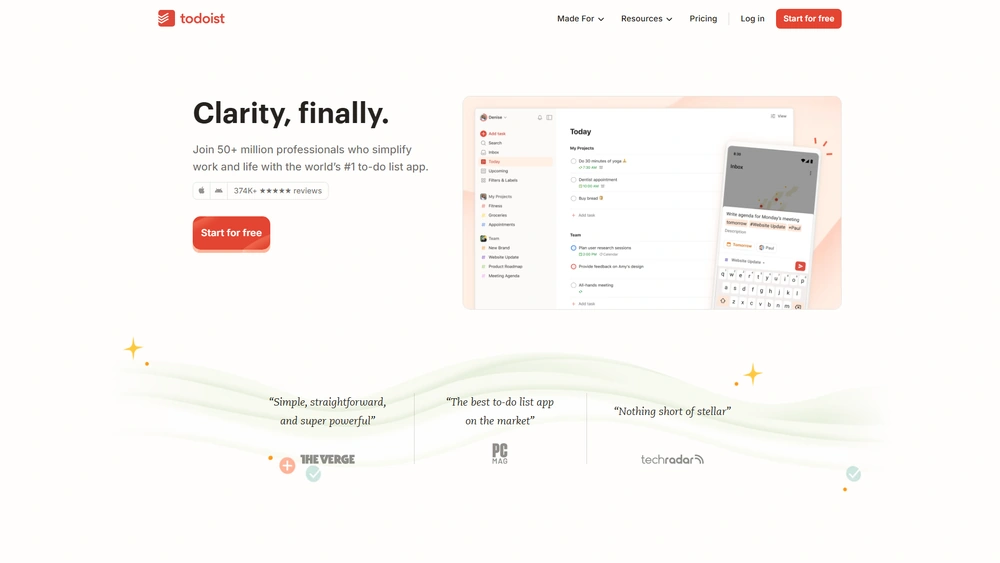Todoist Overview & 2025 Industry Position
Todoist remains a powerhouse in task management, blending simplicity with powerful features to serve more than 30 million users worldwide. Originally launched as a minimalist to-do list, it has expanded into a sophisticated productivity platform beloved by freelancers, professionals, and entire organizations. In 2025, Todoist occupies a premium position in the productivity stack, thanks to continuous refinements, thoughtful AI features, and wide-ranging integrations. It meets the demands of hybrid work, goal tracking, and collaborative task management with minimal friction.
From Launch to 2025: Todoist’s Journey
Todoist’s trajectory began in 2007, when founder Amir Salihefendić sought to create a distraction-free task manager. The web app caught on for its design minimalism and cross-platform capabilities. Key milestones include:
- 2007: Todoist officially launches
- 2014: Mobile apps and cross-device sync introduced
- 2016: Karma system for productivity tracking
- 2018: Foundations for team collaboration added
- 2021: Boards introduced to rival Kanban tools like Trello
- 2023: AI Assistant rolled out in beta
Heading into 2025, Todoist is focused on contextual automation—understanding user patterns to recommend optimal focus areas and adapt workflows preemptively.

Todoist Key Features
Todoist offers a feature set that scales from simple daily planning to project-level task collaboration. Highlights include:
- Smart Task Management: Natural language input, priority flags, recurring tasks, subtasks, and labels
- Karma Productivity Metrics: Gamified tracking of task completion and streaks
- Project Views: Choose between list, board (Kanban), or calendar views
- Collaboration Tools: Shared projects, task assignments, and activity logs
- Todoist AI: Suggests available time slots, reschedules overdue items, and batch-edits tasks
Workflow & UX Design
Todoist’s sleek interface promotes intuitive navigation. Users can type “Meet with Joe every Friday at 10am” and a repeating calendar item is created instantly. Color-coded labels, breadcrumbs, and clean spacing reduce cognitive load. Offline syncing across platforms ensures reliability. The responsive mobile UI is near identical to desktop, making it ideal for hybrid workers.
Pro Tip: Use the “Filter” function with queries like “@work & overdue” to zero in on urgent buckets across projects.
Todoist Pricing Analysis & Value Metrics
As of July 2025, Todoist offers three pricing tiers:
| Plan | Monthly | Key Features |
|---|---|---|
| Free | $0 | 5 active projects, basic task management, mobile/desktop access |
| Pro | $5 | 300 projects, reminders, task durations, AI assistant |
| Business | $8/user | Team workspace, Admin controls, shared project roles, advanced reporting |
The Pro tier offers tremendous value for solo professionals, especially with AI features now fully integrated. Teams can scale affordably using the Business tier’s secure document and permission layers.
Competitive Landscape
Here’s how Todoist compares to other popular productivity apps:
| App | Price Range | Best For | Key Difference |
|---|---|---|---|
| Todoist | $0–$8/user | Individuals, teams | Simple UI, versatile features, AI |
| Trello | $0–$10/user | Visual planners | Kanban-first, fewer automation features |
| Asana | $0–$24.99/user | Scalable teams | Feature-rich, heavier on PM tools |
| ClickUp | $0–$29/user | Power users | Highly customizable, steeper learning |
Use Cases
Todoist is used across a broad ecosystem:
- Freelancers: Track project deliverables and invoice reminders
- Remote Teams: Assign, follow up, and archive tasks across time zones
- Educators: Plan coursework and automate recurring schedules
- Product Managers: Map sprints with boards and integrate with GitHub
- Therapists & Coaches: Schedule sessions, track goals per client
Todoist Integrations
With over 80 integration partners, Todoist meshes into most productivity ecosystems:
- Calendar: Google Calendar, Outlook
- Communication: Slack, Gmail, MS Teams
- Automation: Zapier, IFTTT, Make
- Note-Taking: Evernote, Notion
- DevOps & Tasking: GitHub, Jira
Its API and webhook support allow scalable automation in enterprise contexts.
Pros & Cons
- Pros: Clean UI, AI rescheduling, offline syncing, advanced filtering, robust mobile apps
- Cons: Limited offline collaborative features, cost scales with team size, AI requires paid tier
Final Thoughts
Todoist remains a gold-standard productivity app built for speed and reliability. In 2025, it bridges personal tasking and team collaboration better than ever. If you value minimalist tools with modern capacity, it’s worth every penny. For large-scale PM, it may lack depth—but for everyone else, it’s both sleek and powerful.
Todoist FAQ
Yes, Todoist’s Free plan includes up to 5 projects, mobile and desktop apps, and basic task functionality.
Yes, Todoist offers real-time two-way syncing with Google Calendar, allowing tasks to appear as calendar events.
Absolutely. The Business plan supports shared projects, user roles, and admin-level controls for effective teamwork.
Todoist uses TLS encryption, adheres to GDPR, and offers admin-level oversight for all Business workspaces.
2025 brings expanded AI rescheduling, improved reporting for teams, and enhanced mobile offline modes for pro users.